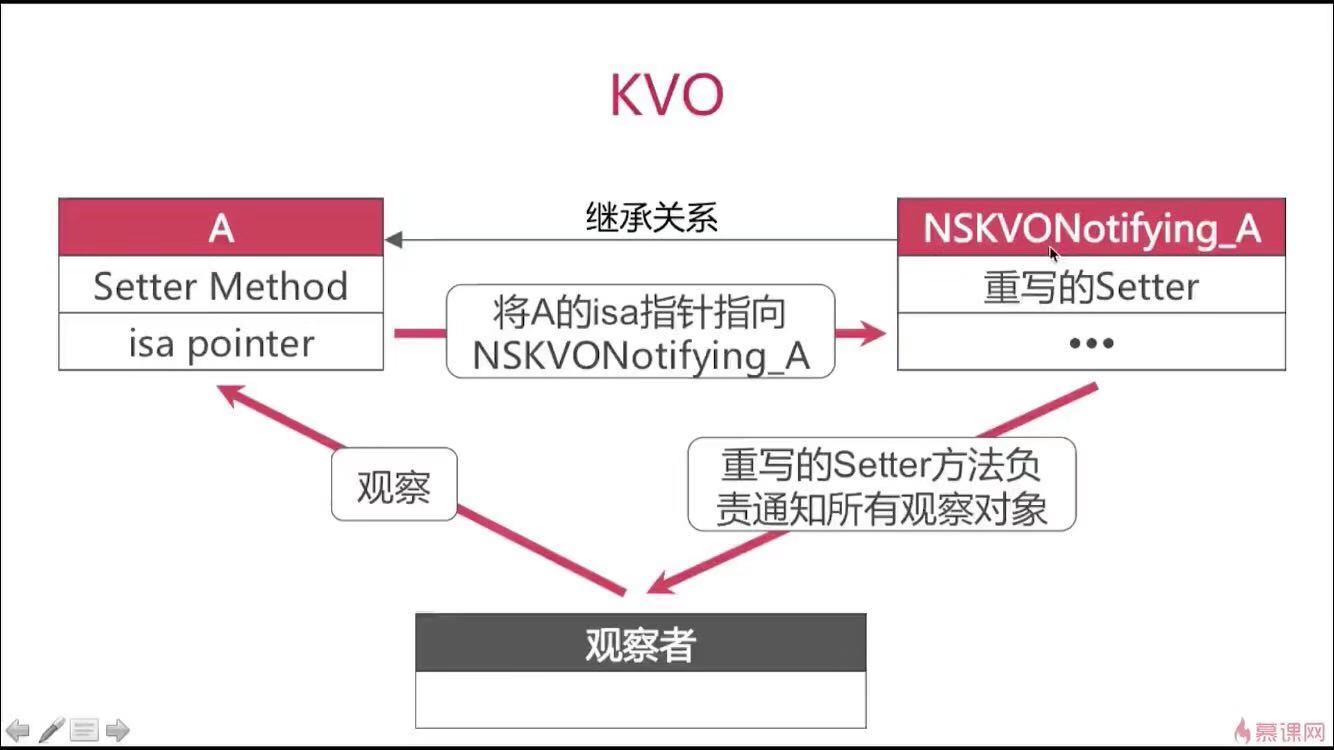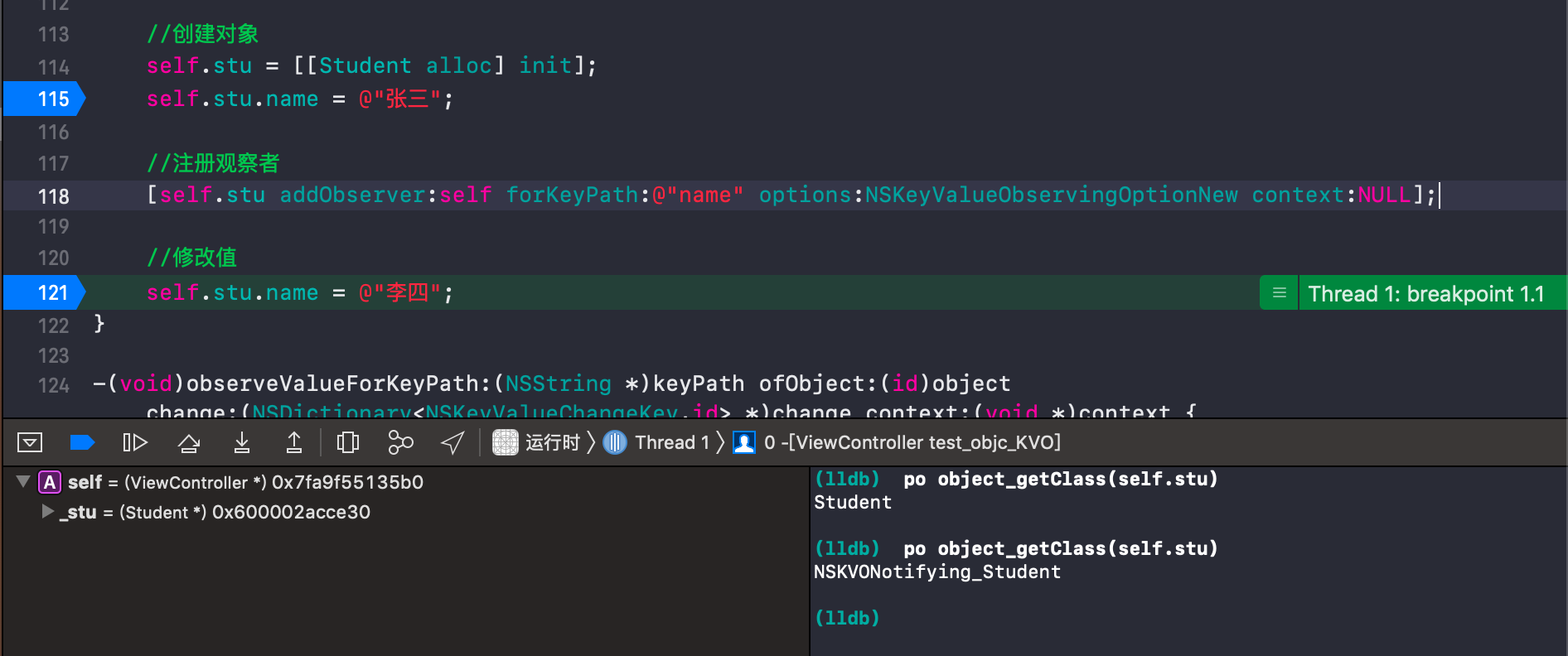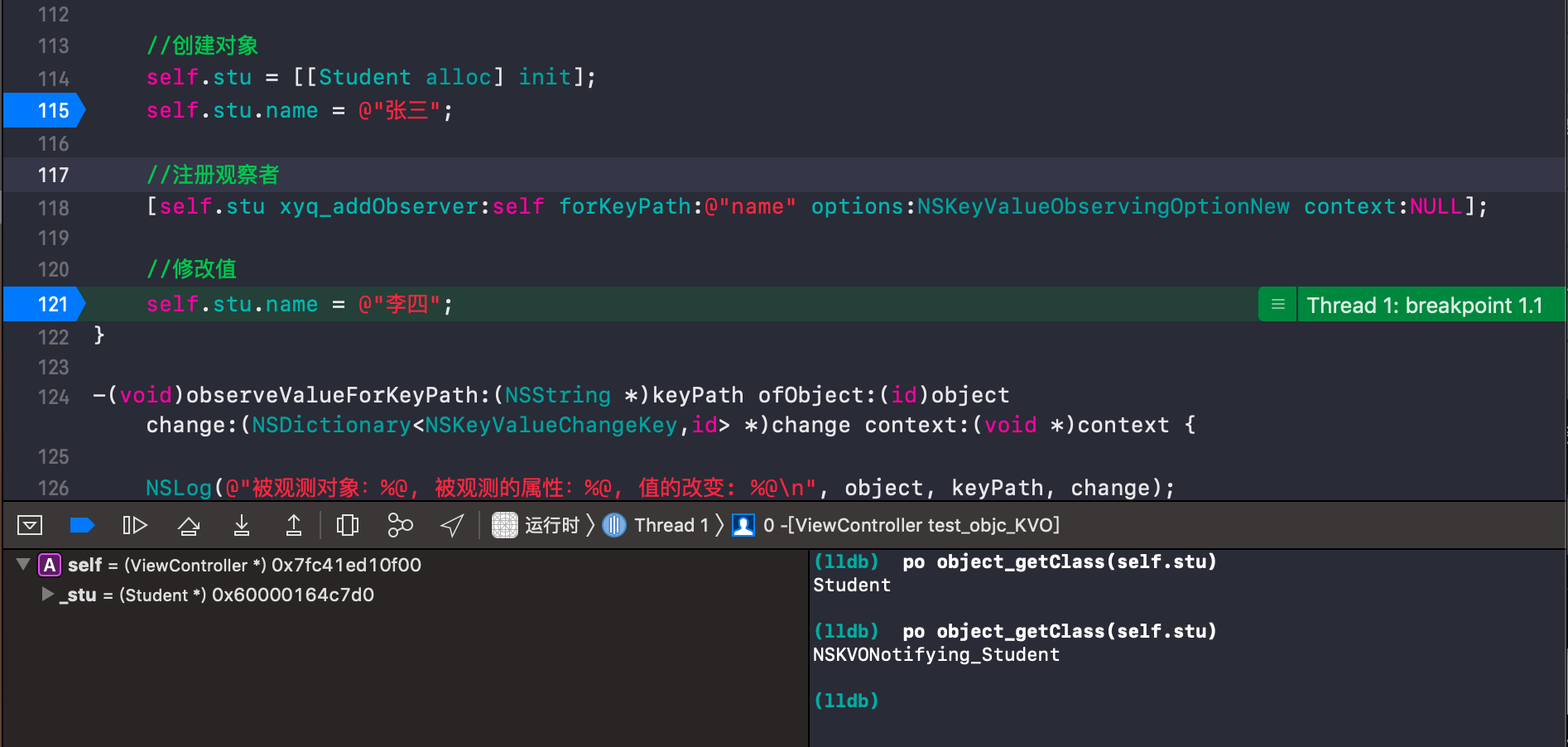一、介绍
什么是KVO?全称key-value-observer,键值观察,观察者设计模式的另一种实现。其作用是通过观察者监听属性值的变化而做出函数回调。
二、原理
KVO基于Runtime机制实现,使用了isa的混写技术
监听者监听类A的某一个属性的变化,系统会动态为类A创建一个子类NSKVONotifying_A,并将类A的isa指针重新指向该子类
系统会重写类A的setter方法。( 赋值前后分别调用willChangeValueForKey和didChangeValueForKey跟踪新旧值 )
当类A的属性发生改变时,系统通知监听者,调用observeValueForKey:ofObject:change:context方法即可
三、图示

三、基本实现
Student类
// Created by 夏远全 on 2019/10/12. #import <Foundation/Foundation.h> NS_ASSUME_NONNULL_BEGIN @interface Student : NSObject @property (nonatomic, copy) NSString *name; @end
ViewController类
-(void)test_objc_KVO { //创建对象 self.stu = [[Student alloc] init]; self.stu.name = @"张三"; //注册观察者 [self.stu addObserver:self forKeyPath:@"name" options:NSKeyValueObservingOptionNew context:NULL]; //修改值 self.stu.name = @"李四"; } -(void)observeValueForKeyPath:(NSString *)keyPath ofObject:(id)object change:(NSDictionary<NSKeyValueChangeKey,id> *)change context:(void *)context { NSLog(@"被观测对象:%@, 被观测的属性:%@, 值的改变: %@\n", object, keyPath, change); }
断点结果:监听前后,stu对象的类类型发生了变化,Student -> NSKVONotifying_Student

打印结果
2019-10-13 11:22:01.251412+0800 运行时[18494:3545181] 被观测对象:<Student: 0x600003d9f3c0>, 被观测的属性:name, 值的改变: { kind = 1; new = "\U674e\U56db"; }
四、自定义
(1)思想:
- 添加监听方法
- 创建一个子类
- 改写父类isa指针
- 关联观察者
- 重写setter方法
- 给父类发送setter消息
- 给观察者发送observeValueForKeyPath:ofObject:change:context:消息
(2)实现
Student类
// Created by 夏远全 on 2019/10/12. #import <Foundation/Foundation.h> NS_ASSUME_NONNULL_BEGIN @interface Student : NSObject @property (nonatomic, copy) NSString *name; ///自定义的监听方法 -(void)xyq_addObserver:(NSObject *)observer forKeyPath:(NSString *)keyPath options:(NSKeyValueObservingOptions)options context:(nullable void *)context; @end NS_ASSUME_NONNULL_END
// // Student.m // 运行时 // // Created by 夏远全 on 2019/10/12. // #import "Student.h" #import <objc/message.h> @implementation Student void setterMethod(id self, SEL _cmd, NSString *name) { //5、调用父类的方法 struct objc_super superClass = { self, class_getSuperclass([self class]) }; objc_msgSendSuper(&superClass, _cmd, name); //6、通知观察者调用observeValueForKeyPath:ofObject:change:context: id observer = objc_getAssociatedObject(self, (__bridge const void *)@"observer"); NSString *methodName = NSStringFromSelector(_cmd); NSString *key = getValueKey(methodName); objc_msgSend(observer, @selector(observeValueForKeyPath:ofObject:change:context:), key, self, @{key:name}, nil); } /// 通过set方法截取属性名 NSString *getValueKey(NSString *setter){ //去掉setter if ([setter hasPrefix:@"set"]) { setter = [setter stringByReplacingOccurrencesOfString:@"set" withString:@""]; } //去掉: if ([setter hasSuffix:@":"]) { setter = [setter stringByReplacingOccurrencesOfString:@":" withString:@""]; } //首字母小写 NSString *key = [setter stringByReplacingOccurrencesOfString:[setter substringToIndex:1] withString:[[setter substringToIndex:1] lowercaseString] options:0 range:NSMakeRange(0,1)]; return key; } - (void)xyq_addObserver:(NSObject *)observer forKeyPath:(NSString *)keyPath options:(NSKeyValueObservingOptions)options context:(nullable void *)context { //1、生成子类 const char * clazz = class_getName([self class]); NSString *className = [NSString stringWithCString:clazz encoding:NSUTF8StringEncoding]; NSString *subClassName = [NSString stringWithFormat:@"NSKVONotifying_%@",className]; Class subClass = objc_getClass(subClassName.UTF8String); subClass = objc_allocateClassPair([self class], [subClassName UTF8String], 0); objc_registerClassPair(subClass); //2、isa指向子类 object_setClass(self, subClass); //3、关联观察者 objc_setAssociatedObject(self, (__bridge const void *)@"observer", observer, OBJC_ASSOCIATION_RETAIN_NONATOMIC); //4、重写set方法 NSString *setNameStr = [NSString stringWithFormat:@"set%@:",keyPath.capitalizedString]; SEL setSelector = NSSelectorFromString(setNameStr); class_addMethod(subClass, setSelector, (IMP)setterMethod, "v@:@"); } @end
ViewController类
-(void)test_objc_KVO { //创建对象 self.stu = [[Student alloc] init]; self.stu.name = @"张三"; //注册观察者 [self.stu xyq_addObserver:self forKeyPath:@"name" options:NSKeyValueObservingOptionNew context:NULL]; //修改值 self.stu.name = @"李四"; } -(void)observeValueForKeyPath:(NSString *)keyPath ofObject:(id)object change:(NSDictionary<NSKeyValueChangeKey,id> *)change context:(void *)context { NSLog(@"被观测对象:%@, 被观测的属性:%@, 值的改变: %@\n", object, keyPath, change); }
断点结果:监听前后,stu对象的类类型发生了变化,Student -> NSKVONotifying_Student

打印结果
2019-10-13 11:35:17.929772+0800 运行时[18720:3562649] 被观测对象:<NSKVONotifying_Student: 0x6000002e0420>, 被观测的属性:name, 值的改变: { name = "\U674e\U56db"; }
五、扩展
这个案例只是浅浅的探究了一下实现原理,其他这个还有更大的应用。
我们可以给NSObject创建一个分类NSObject(KVO),实现各种属性的监听实现。
具体操作自己动手去吧,不在本文做演示。